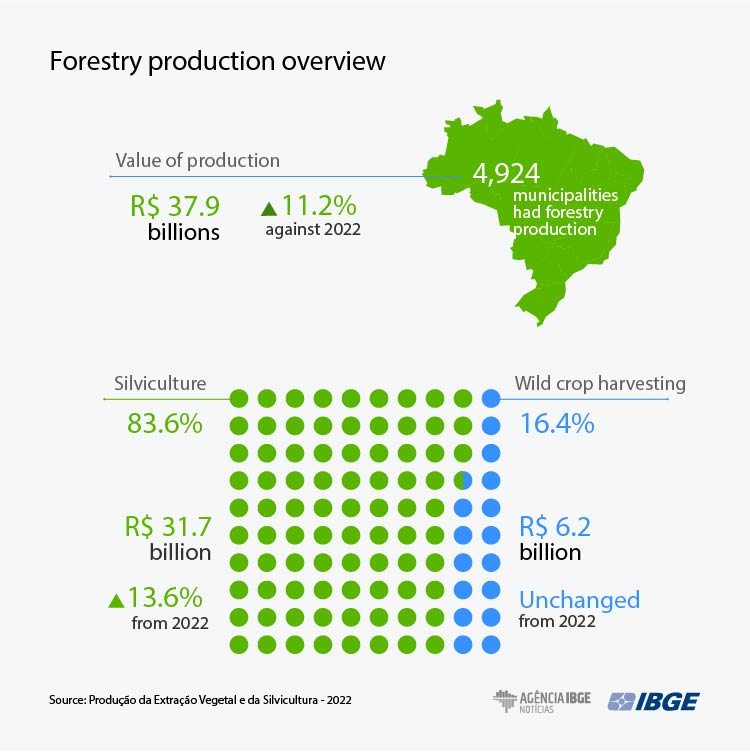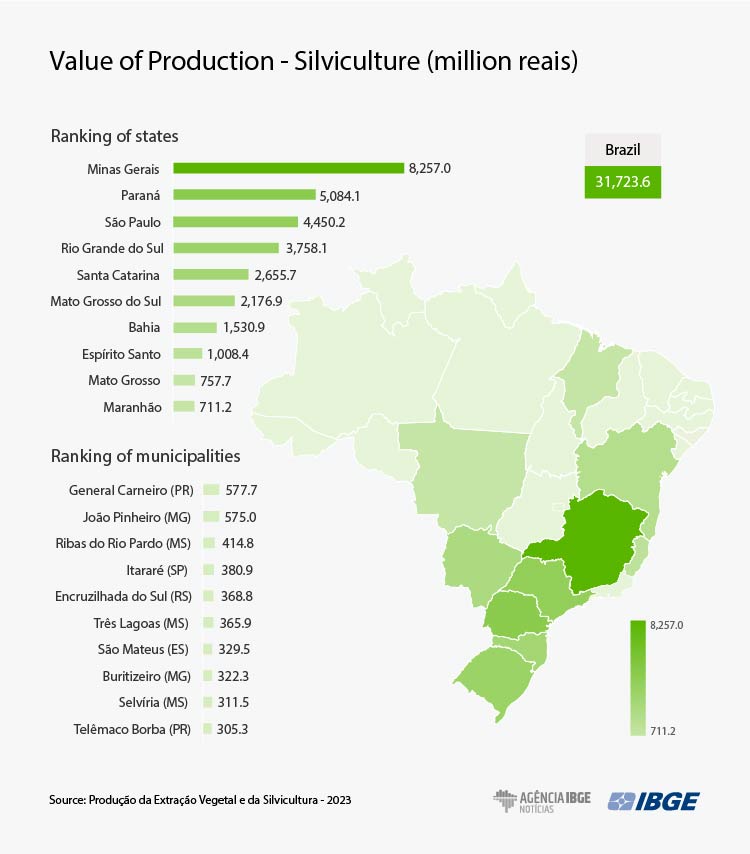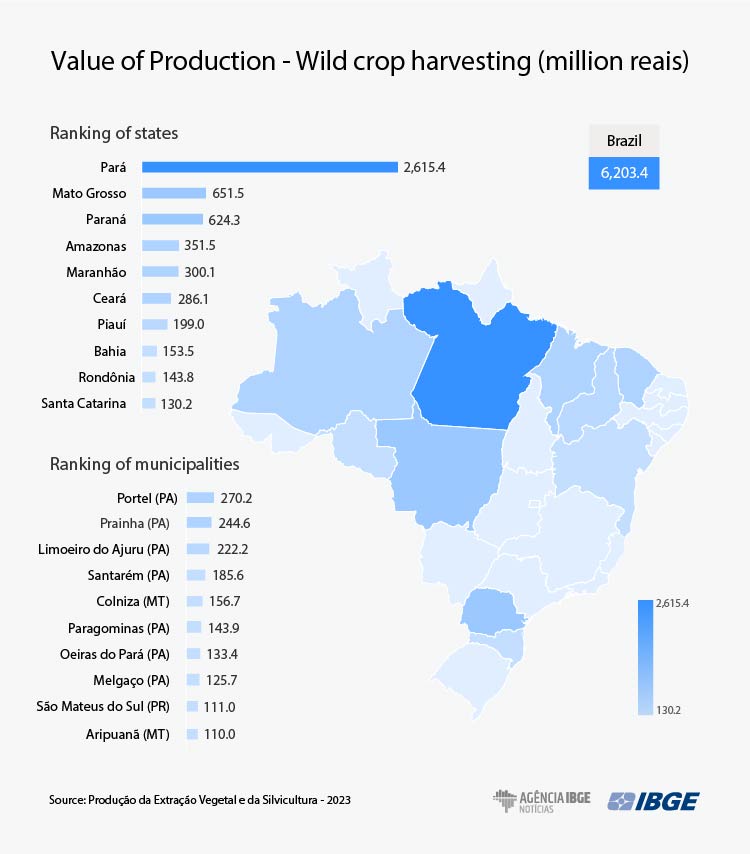PEVS
Value of production of silviculture and of wild crop harvesting increases by 11.2% and amounts to R$ 37.9 billion
September 26, 2024 10h00 AM | Last Updated: October 01, 2024 05h49 PM
Highlights
- In 2023, value of forestry production hit a record R$ 37.9 billion, with an increase of 11.2% from 2022, and production in 4,924 municipalities.
- Value of production of silviculture increased by 13.6% and reached R$31.7 billion. As for wild crop harvesting, there was hardly any change in value of production (r4 6.2 billion) from 2022.
- Silviculture added up to 9.7 million hectares, of which 78.1% are mainly used in the pulp industry.
- Minas Gerais still accounts for the highest value of production of silviculture, reaching R$ 8.3 billion in 2023, or 26.0% of the total. The state is the biggest producer of charcoal, with 88.1% of the national volume.
- General Carneiro (PR) remained as the leader in the silviculture value of production, reaching R$ 577.7 million in 2023, despite the drop of 8.4%.
- The group of wood products, which had biggest participation in value of production of wild crop harvesting (64.2%), had a slight increase of 0.5% from the previous year, after a drop of 0.2% in 2022.
- The states of Mato Grosso and Pará accounted for 62.6% of the total amount of logged wood extracted, representing 79.1% of value if production for this item.
- In 2023, the value of production of non-wood products dropped by 0.9%, amounting to R$ 2.2 billion. Acai, with R$ 853.1 million, yerba mate, with R$ 589.6 million, are the products which generate higher production value.

Value of forestry production reched a record figure, R$ 37.9 billion, in 2023, with an increase of 11.2% and production in 4,924 municipalities. Value of silviculture is still above that of wild crop harvesting, as observed since 1998. Silviculture is still on an upward trend, as in the last few years, having reached R$ 31.7 billion, an increase of 13.6% against the figure in 2022.
Wild crop harvesting remained stable, with a change of 0.0% from the previous year, when there was a change of 0.2%. So, the value of production reached in 2022 stood at R$ 6.2 billion. These data come from the Survey of Forestry Activities (PEVS) 2023, released today (26), by the IBGE.
“We can analyze that a lot of the increase in value of production of silviculture comes from the prices of product. We see increases in the amount produced, but the price was the main factor. As an example, logged wood increased by 3.0% in amount and 28.1% in value,” says the manager of Agriculture of IBGE, Carlos Alfredo Guedes.
Th researcher also explains that there is still a trend to increase of silviculture in relation to wild crop harvesting. That does not mean wild crop harvesting has decreased, but thar the value of silviculture production has been growing. In 2023, silviculture had a participation of 83.6% in value of producion, whereas wild crop harvesting registered 16.4%. The distribution had been of 81.5% and 18.5%, respectively, in 2022.

In 2023, there was an increase of 2.5% in the area of planted forests in the country, that is, 238.0 thousand hectares. The total area of silviculture reached 9.7 million hectares, of which 7.6 million are eucalyptus, mainly used in the pulp and paper industry. Together, eucalyptus and Pinus were responsible for the coverage of 96.3% of the silviculture areas for commercial use in the country.
As for Major Regions, the Central West (13.5%), Southeast (1.1%) and North (0.2%) recorded increases in 2023 whereas small decreases, of 0.5% and 0.1%, were observed in the Northeast and South, respectively.
“A highlight observed by the survey in 2023 was this increase in the central West, mainly Mato Grosso do Sul, which increased its silviculture area and then had the biggest area of planted forests. That does not necessarily indicate the substitution of other areas, but expansion,” the Agriculture manager of the IBGE highlights.
According to data of the Secretariat of Foreign Trade (SECEX), of the Ministry of Development, Industry, Trade and Services, cellulose was in the tenth position in the ranking of total exports in the country in 2023 (2,3%), with 19.1 million metric tons exported, having generated 7.9 billion dollars, a drop of 5.3% from 2022.
The sector of logged wood for Pulp and paper remains on an upward trend, having reached R$ 11.7 billion, an increase of 19.4% in value of production, after a growth of 35.4% registered a year ago. “Brazil is the main world exporter of pulp. The main destinations in 2023 were China, United States, Netherlands and Italy,” the researcher points out.
The participation of wood products remains as the majority in silviculture, representing 98.2% of the forest value of production. Wood products coming from planted areas for commercial purposes registered an increase of 15.4% in value of production, whereas those resulting from wild crop harvesting recorded an increase of 0.5%.
Among wood products in silviculture, all the groups recorded increase in value of production, mainly firewood, which increased by 20.6%. The value of production of wood for pulp and paper increased by 19.4%; charcoal, 6.5%; and logged wood for other purposes, 16.2%.
Wild crop harvesting recorded an increase in value added in 2019 (6.8%), 2020 (5.8%) and 2021 (31.6%), but in 2022 recorded a drop of 0.3% and in 2023 there was a slight decrease of R$ 132 thousand in current values. While food products account for all the value of silviculture production (98.2%); in wild crop harvesting this group represents 64.2%, followed by food products (29.9%), waxes (3.6%), oil seeds (1.6%) and other (0.7%).
Minas Gerais has the highest value of silviculture production: R$ 8.3 billion
Minas Gerais still holds the highest value of silviculture production, which increased by 7.5%, reaching R$ 8.3 billion in 2023, or 26.0% of the total of silviculture. The state is the main producer of coal, with 88.1% of the national volume.
Paraná is in the second position in terms of value of production of planted forests, R$ 5.1 billion. It is the main producer of logged wood for other purposes, responsible for 38.1% of the national total. Production increased by 9.2%, and reached 22.9 million cubic meters, and value of production increased by 191%, reaching R$ 2.8 billion in nominal terms.
Regarding planted area, Minas Gerais still holds the biggest area covered with forest species in the country, with 2.1 million hectares, which means a growth of 1.7% against the previous year, being mostly composed of eucalyptus (97.4%). The silviculture area in Mato Grosso do Sul increased by 15.2%, in the second position in terms of planted forests, with 1.4 million hectares, of which 99.5% are eucalyptus. São Paulo has 1.2 million hectares, an increase of 0.1%, being after Mato Grosso do Sul, which was in the second position.

Among the 10 municipalities with the biggest planted forest areas in Brazil, five are in Mato Grosso do Sul; three, in Minas Gerais; one, in Rio Grande do Sul; and one, in Bahia.
Four municipalities in Mato Grosso do Sul are in the top positions regarding planted area in the country, having Ribas do Rio Pardo and Três Lagoas as highlights, with 325.0 thousand hectares (an increase of 29.3%) and 288.0 thousand hectares, (an increase of 9.1%), respectively.
“Following the increase in the Central West Region and in Mato Grosso do Sul, a relevant point observed in 2023, at municipal level, was this presence of other municipalities in the state in the ranking of planted forests in Brazil,” Guedes explains.
Buritizeiro is the municipality with the biggest silviculture area in Minas Gerais. In Bahia, the highlight is Caravelas, whereas in Rio Grande do Sul, Encruzilhada do Sul stands out, with areas mainly covered with eucalyptus and Pinus. The last three ones are part of the areas of influence of and of industrial complexes for the production of pulp and paper.
Paraná leads national production of firewood from silviculture
With an estimated amount of 13.8 million cubic meters, corresponding to 24.9% of the national total, Paraná also stood out in the production of firewood coming from planted forests. Rio Grande do Sul was the second main producer of wood, having reached 12.2 million cubic meters, 21.9% of the national total. The South Region accounts for 61.0% of the national production of firewood.
General Carneiro is the municipality with the highest value of silviculture production
The municipality of General Carneiro (Paraná), despite a drop of 8.4%, led the ranking of value of silviculture production, reaching a total of R$ 577.7 million in 2023. The municipality, which is the main producer of logged wood for other purposes, recorded a drop of 17.2%, as well as in logged wood for pulp and paper, which dropped by 3.4%. A highlight was the increase of 275.0% in amount and of 348.1% in value of production of charcoal.
João Pinheiro (Minas Gerais), second municipality in the ranking of value of silviculture production, with R$ 575.0 million, stood out in the production of charcoal, with 437.2 thousand metric tons. That generated R$ 524.7 million, an increase of 8.9%, corresponding to 91.2% of the value of silviculture production in the municipality.
Ribas do Rio Pardo (Mato Grosso do Sul) went from the ninth to the third biggest municipality in terms of value of silviculture production, generating R$ 414.8 million, a highlight in the production of logged wood for pulp and paper, with 4.1 million cubic meters, an increase of 28.1% in terms of volume, against the previous year. Value of production increased by 47.2%, generating R$ 331.2 million in nominal terms.
Wild crop harvesting repeats result of 2022 and generates R$ 6.2 billion in value of production in 2023
In 2023, value of production obtained from wild crop harvesting dropped by R$ 132.0 thousand, amounting to R$ 6.2 billion, which evidences some stability in relation to 2022. Of the groups of products that form wild crop harvesting in the survey, there were drops in the value of production of waxes (18.8%), hard rubber (100.0%) and pine knot (8.7%).
The group of wood products, which accounted for the biggest share in values of production of wild crop harvesting (64.2%), registered a small increase of 0.5% against the previous year, after a drop of 0.2% in 2022. So, there was stability in the last three years. Up to 2020, the exploitation of wild crop harvesting has lost space in the country, being gradually replaced by that originated from planted forests. However, in 2021, there was a significant increase influenced by the production of logged wood.

The states of Mato Grosso and Pará accounted, together, for 62.6% of the total logged wood extracted, representing 79.1% of the value of production for this product. Pará, which, in 2022 surpassed Mato Grosso one more, remains as the main producer of logged wood also in 2023, reaching 5.0 milllion cubic meters, with an increase of 5.0% in extraction.
Acai and yerba mate keep highest value of production among non-wood products
In 2023, the sum of value of production of non-wood products recorded a drop of 0.9%, amounting to R$ 2.2 billion. The group of food products, the biggest one among non-food products from wild crop harvesting, recorded an increase in production (0.9%), amounting to R$ 1.85 billion.
Acai from the Amazon is collected from the regional native palm tree, concentrating 92.1% of its extraction in the North Region. In 2023, this production reached 238.9 thousand metric tons, 3.3% below that obtained in the previous year. In terms of nominal value, there was an increase of 2.8%, resulting in a total R$ 853.1 million. Pará registered the biggest production of acai, with 167.6 thousand metric tons, which represents 70.2% of the national total. With an increase of 1.7% in amount and of 1.4% in value of production, this Federation Unit reached R$ 651.1 million.
In the ranking that registered the biggest volumes, in 2023, eight are from Pará, and the municipality of Limoeiro do Ajuru remains in the position as main national producer of acai, accounting, alone, for 21.3% of the national total, with a positive change of 2.0% against 2022.
Extraction of yerba mate, which is concentrated in the South Region, generated the second biggest value of production among non-wood products, with R$ 589.6 million, with a drop of 9.1% from 2022. production reached 425.8 thousand metric tones, with a drop of 3.6% from the previous year. In Paraná, which holds 87.0% of the national production, holds the 10 municipalities with the biggest production of yerba mate in 2023, with São Mateus do Sul as a highlight with the biggest volume extracted, 15.3% of the national total, and an increase of 3.2% against what was presented in the previous survey.
About the survey
PEVS 2023 presents information on the area, amount produced and value of production based on the exploitation of planted forests (silviculture) and of natural vegetation resources (wild crop harvesting).
Wild crop harvesting encompasses 37 itens, with a highlight to wood products, food products, waxes and oil seeds. Silviculture includes, among which are charcoal, firewood, logged wood and resin.




















